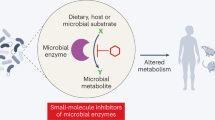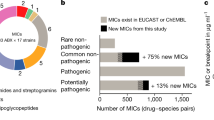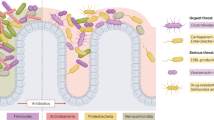Abstract
Mesalamine serves as the gold standard in treating ulcerative colitis. However, its precise mechanism(s) of action remains unclear. Here, we show that mesalamine treatment rapidly decreases polyphosphate levels in diverse bacteria, including members of the human gut microbiome. This decrease sensitizes bacteria towards oxidative stress, reduces colonization and attenuates persister cell and biofilm formation, suggesting that mesalamine aids in diminishing the capacity of bacteria to persist within chronically inflamed environments.
This is a preview of subscription content, access via your institution
Access options
Access Nature and 54 other Nature Portfolio journals
Get Nature+, our best-value online-access subscription
$29.99 / 30 days
cancel any time
Subscribe to this journal
Receive 12 digital issues and online access to articles
$119.00 per year
only $9.92 per issue
Buy this article
- Purchase on Springer Link
- Instant access to full article PDF
Prices may be subject to local taxes which are calculated during checkout


Similar content being viewed by others
References
Rao, N. N., Gómez-García, M. R. & Kornberg, A. Annu. Rev. Biochem. 78, 605–647 (2009).
Gray, M. J. et al. Mol. Cell. 53, 689–699 (2014).
Hauso, Ø., Martinsen, T. C. & Waldum, H. Scand. J. Gastroenterol. 50, 933–941 (2015).
Feagan, B. G. & MacDonald, J. K. Inflamm. Bowel Dis. 18, 1785–1794 (2012).
Kuroda, A. et al. Proc. Natl Acad. Sci. USA 96, 14264–14269 (1999).
Shiba, T., Tsutsumi, K. & Yano, H. Proc. Natl Acad. Sci. USA 94, 11210–11215 (1997).
van Hogezand, R. A. et al. Eur. J. Clin. Pharmacol. 43, 189–192 (1992).
Andrews, C. N. et al. Aliment. Pharmacol. Ther. 34, 374–383 (2011).
Yu, A. et al. Mol. Pharmaceutics (in the press).
Jandhyala, S. M. et al. World J. Gastroenterol. 21, 8787–8803 (2015).
Lim, W. C., Wang, Y., MacDonald, J. K. & Hanauer, S. Cochrane Database Syst. Rev. http://doi.org/bwwv (2016).
Sambrook, J., Fritsch, E. F. & Maniatis, T. Molecular Cloning: A Laboratory Manual 2nd edn (Cold Spring Harbor Laboratory Press, 1999).
Datsenko, K. A. & Wanner, B. L. Proc. Natl Acad. Sci. USA 97, 6640–6645 (2000).
Liberati, N. T. et al. Proc. Natl Acad. Sci. USA 103, 2833–2838 (2006).
Cameron, D. E., Urbach, J. M. & Mekalanos, J. J. Proc. Natl Acad. Sci. USA 105, 8736–8741 (2008).
Ault-Riché, D. et al. J. Bacteriol. 180, 1841–1847 (1998).
Birnboim, H. C. Nucleic Acids Res. 7, 1513–1523 (1979).
Kumble, K. D. & Kornberg, A. J. Biol. Chem. 270, 5818–5822 (1995).
Brawerman, G., Mendecki, J. & Lee, S. Y. Biochemistry. 11, 637–641 (1972).
Maciag, A. et al. Nucleic Acids Res. 39, 5338–5355 (2011).
Pfaffl, M. W. Nucleic Acids Res. 29, e45 (2001).
Gray, M. J., Wholey, W.-Y., Parker, B. W., Kim, M. & Jakob, U. J. Biol. Chem. 288, 13789–13798 (2013).
Cremers, C. M. et al. Mol Cell. 63, 768–780 (2016).
Zhou, Y., Smith, D. R., Hufnagel, D. A. & Chapman, M. R. Methods Mol. Biol. 966, 53–75 (2013).
Maisonneuve, E. & Gerdes, K. Cell 157, 539–548 (2014).
Portal-Celhay, C. & Blaser, M. J. Infect. Immun. 80, 1288–1299 (2012).
Acknowledgements
The authors acknowledge the University of Michigan Center for Chemical Genomics for assistance with high-throughput screening. The authors thank K. Vendrov for killing the mice and preparing caecal samples, D. Knoefler for help with the statistical analyses and C.M. Cremers for help with establishing the assay for quantification of steady-state polyP levels. The authors thank L. Xie and K. Wan for their help with the purification of PPX and PPK, respectively. This work was funded by the National Institute of Health grants GM065318 (to U.J.), AI090871 and AI24255 (to V.B.Y.) and by FDA grants HHSF223201000082C and HHSF223201300460A (to D.S.). Clinical samples were collected with help from the Michigan Institute for Clinical & Health Research (MICHR) NIH grant UL1TR000433. J.-U.D. is supported by a postdoctoral fellowship from the Deutsche Forschungsgemeinschaft grant DA1697/1-1.
Author information
Authors and Affiliations
Contributions
J.-U.D., M.J.G., D.B. and F.B. designed and carried out experiments. M.J.K., Y.W., J.R.B., W.L.H. and D.S. designed and carried out the biopsies of the human GI samples and the subsequent analyses of mesalamine concentrations. J.-U.D., M.J.G. and U.J. conceived the study, interpreted the results and wrote the manuscript. V.B.Y. was involved in conceiving the experiments for detection of polyP in the caecal contents of mice. J.L. was involved in establishing the assay for quantification of steady-state polyP levels.
Corresponding author
Ethics declarations
Competing interests
The authors declare no competing financial interests.
Supplementary information
Supplementary Information
Supplementary Figures 1 and 2, Supplementary Table 1, Supplementary Notes and Discussion, Supplementary Methods and Supplementary References. (PDF 2242 kb)
Rights and permissions
About this article
Cite this article
Dahl, JU., Gray, M., Bazopoulou, D. et al. The anti-inflammatory drug mesalamine targets bacterial polyphosphate accumulation. Nat Microbiol 2, 16267 (2017). https://doi.org/10.1038/nmicrobiol.2016.267
Received:
Accepted:
Published:
DOI: https://doi.org/10.1038/nmicrobiol.2016.267
This article is cited by
-
An inorganic mineral-based protocell with prebiotic radiation fitness
Nature Communications (2023)
-
Escherichia coli Nissle 1917 secondary metabolism: aryl polyene biosynthesis and phosphopantetheinyl transferase crosstalk
Applied Microbiology and Biotechnology (2021)
-
Model systems for studying polyphosphate biology: a focus on microorganisms
Current Genetics (2021)
-
Recent advances in mesalamine colonic delivery systems
Future Journal of Pharmaceutical Sciences (2020)
-
Bacterial polyphosphates interfere with the innate host defense to infection
Nature Communications (2020)



